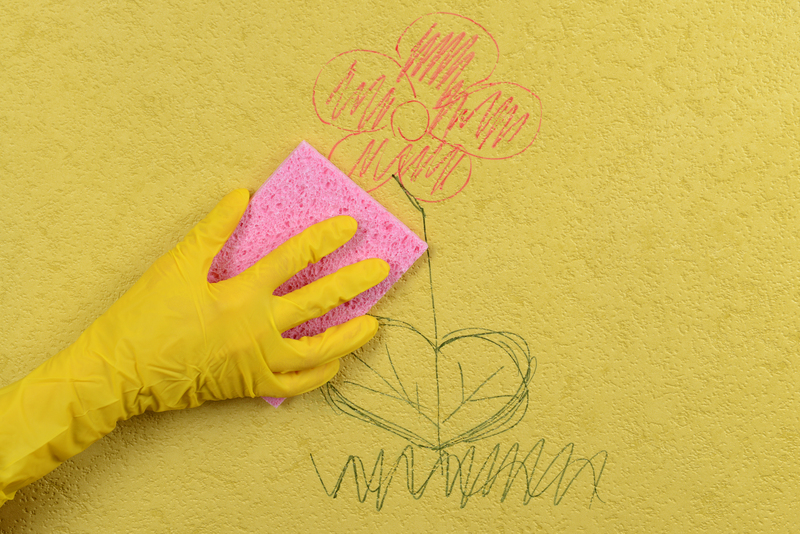Reclaim Your Stovetop's Shine: Secrets to Removing Burnt-On Spots
Posted on 25/05/2025
Reclaim Your Stovetop's Shine: Secrets to Removing Burnt-On Spots
Is your stovetop looking less than sparkling lately? Burnt-on spots, spills, and stubborn stains are a common headache in even the tidiest of kitchens. If you're yearning for a gleaming cooktop and want to know the most effective secrets for removing burnt-on spots, you've landed in the right place!
In this comprehensive guide, we'll dive deep into proven methods, easy-to-follow routines, preventive tips, and the best products to help you restore your stovetop's shine. Learn all the essential tricks for removing burnt-on stains, regardless of your cooktop's type--gas, electric, or glass-ceramic.
Understanding Burnt-On Spots: Why are They So Stubborn?
Many cooking mishaps, from boiling over sauces to overcooked pots and pans, can cause food residue to carbonize and cling tightly to your stovetop. Burnt-on stains often resist ordinary wiping or cleaning solutions, embedding themselves into the surface and marring your stovetop's appearance.
Addressing burnt-in spots as soon as possible is essential to restore your cooktop's shine and prevent further damage. But first, let's understand why these stains are so tough:
- High Heat: Cooking at high temperatures causes liquids and food to carbonize, creating tough, black or brown spots.
- Repetitive Cooking: Ignored spills become harder to remove with each heating cycle.
- Poor Cleaning Habits: Delaying cleaning allows grease and residue to build up.
- Type of Stovetop: Certain surfaces, like glass-ceramic or enamel, are more prone to noticeable scorch marks.
Knowing the source helps you combat burnt-on stovetop stains more effectively--and prevent them in the future!

Essential Preparations Before Cleaning Burnt-On Spots
Before getting started, safety is key. Always let your stovetop cool completely before tackling any stains. If you're working with gas burners, disconnect the power and remove grates, knobs, and burner covers as needed.
Gather Your Cleaning Arsenal
- Non-abrasive sponges or cloths
- Soft plastic or silicone scraper
- Baking soda and white vinegar
- Dish soap
- Commercial cleaners (designed for your stovetop type)
- Old toothbrush
- Paper towels or microfiber cloths
- Rubber gloves (especially when using chemical cleaners)
Having the right tools at hand will ease the process of returning your stovetop's shine!
Top Methods for Removing Burnt-On Spots and Stains
1. Baking Soda and Vinegar: The Time-Tested Combo
This eco-friendly method is highly effective for most stovetop stains--especially glass, ceramic, and stainless steel surfaces. Baking soda is a gentle abrasive that lifts carbonized residue, while vinegar dissolves grease and neutralizes odors.
- Sprinkle a generous amount of baking soda over the burnt spots.
- Soak a clean cloth in white vinegar. Lay the vinegar-soaked cloth over the area for 15-20 minutes.
- Gently scrub the softened area with a non-abrasive sponge or brush.
- Wipe with a damp microfiber cloth. Repeat if needed for stubborn stains.
This method works wonders for removing burnt-on stains naturally, being gentle on enamel, ceramic, and glass cooktops alike!
2. Dish Soap and Hot Water Soak
Tackle recent spills or less severe scorch marks by letting dish soap and heat do the heavy lifting.
- Fill a bowl with very hot water and a few drops of degreasing dish soap.
- Drape a wet cloth or paper towel over the burnt area. Let it soak for 15-30 minutes to loosen debris.
- Wipe away softened residue. For remaining spots, use a soft brush or non-abrasive sponge in circular motions.
Pro Tip: Avoid metal pads or harsh scrubbers, as they may scratch and dull your cooktop's shine, especially on glass and enamel surfaces.
3. Razor Blade Scraper (Glass Stovetops Only)
For glass cooktops, a razor blade scraper is highly effective in safely lifting off burnt-on stains
- Hold the blade at a 45? angle and gently scrape carbonized residue off the glass surface.
- Work slowly and carefully to avoid scratching.
- Wipe clean with a damp microfiber cloth.
Never use this method on enamel or stainless steel stovetops, as it may scratch them.
4. Store-Bought Cleaners for Stovetop Burnt-On Spots
Commercial stovetop cleaners are formulated for tough, stuck-on stains and offer great convenience. Be sure to follow the product's instructions carefully to avoid damage:
- Apply a small amount of cleaner directly onto the burnt spot.
- Allow it to sit according to the directions.
- Wipe and rinse thoroughly with a clean, damp cloth.
For glass-ceramic and induction cooktops, use only products marked safe for those surfaces.
Cleaning Tips for Every Type of Stovetop
Glass and Ceramic Stovetops
- Avoid steel wool and abrasive powders, which will permanently scratch and dull the finish.
- Use non-abrasive cleaners specifically formulated for glass surfaces.
- Wipe spills immediately to prevent burning next time you cook.
Gas Stovetops (Enamel or Stainless Steel)
- Remove burner grates, caps, and knobs before cleaning.
- Soak removable parts in hot, soapy water for deep cleaning.
- Scrub gently with a toothbrush or sponge; for stainless steel, wipe in the direction of the grain to prevent streaking.
Electric Coil Stovetops
- Unplug coils and let them cool completely.
- Clean drip pans underneath coils by removing and soaking in warm, soapy water.
- Never immerse heating coils in water. Instead, wipe with a damp cloth and thoroughly dry.
Natural Solutions Versus Commercial Cleaners
| Natural Solutions | Commercial Cleaners |
|---|---|
|
|
Pros:
|
Pros:
|
Preventive Tips: Keeping Your Stovetop Gleaming
Once you reclaim your cooktop's shine by removing burnt-on stains, use these maintenance secrets to keep it looking pristine:
- Wipe spills immediately: Use a damp cloth to remove fresh splatters before they bake on.
- Use lids and splatter guards: Prevent boil-overs and flying grease by covering pots and pans.
- Cure glass cooktops with protective creams: These create a barrier that makes removing burnt-on spots easier in the future.
- Deep-clean weekly: Even if stains are minor, a weekly cleaning keeps residue from carbonizing.
- Remove burners and parts for soaking: Monthly or as needed for gas stoves.
- Cook at lower heat when possible: High heat accelerates burning and stains.
Frequently Asked Questions About Burnt-On Stovetop Spots
How do I remove heavy, black burnt-on stains that won't budge?
If natural solutions fail, try a commercial cream cleaner for your specific stovetop type. Let it sit for several minutes. On glass surfaces, use a razor blade angled gently to avoid scratches. Repeat the process as needed, and never use steel wool on glass or enamel stovetops.
Can I use bleach to clean burnt-on stains?
Bleach is not recommended for most stovetop surfaces. It can discolor, etch, or corrode both glass and metal finishes. Stick to baking soda, vinegar, or gentle commercial cleaners for optimal results.
How do you get burnt milk off a glass ceramic stovetop?
Soak the area with vinegar, cover with a baking soda paste, and let it sit for 20 minutes. Carefully scrape with a plastic or razor blade scraper, then polish with a microfiber cloth. Repeat if necessary; milk can be particularly stubborn but will usually come off with patience.
Is it possible to restore shine to an old, dull stovetop?
Often, yes! Elbow grease, regular cleaning, and specialized stovetop polishes (especially for glass and stainless steel) can greatly improve the appearance of worn cooktops. In severe cases with deep scratches or discoloration, professional refinishing or replacement might be the best solution.

Best Products for Removing Burnt-On Stains and Polishing Stovetops
Looking for reliable cleaners to help you restore your stovetop's shine? Here are high-rated options:
- Weiman Cooktop Cleaner and Polish: Safe for glass and ceramic, removes heavy burnt-on food, leaves a streak-free shine.
- Bar Keepers Friend Cooktop Cleaner: Removes stubborn stains, mineral deposits, and hard water marks from multiple surfaces.
- Affresh Cooktop Cleaning Kit: Includes cleaner, a scraper, and pads for gentle but thorough cleaning of glass and ceramic cooktops.
- Bon Ami Powder Cleanser: All-natural, chlorine-free option for enamel and stainless steel tops.
- Mr. Clean Magic Eraser: Ideal for tough marks on metal burner covers and enameled stove parts (avoid on delicate glass surfaces).
Conclusion: Restore Your Stovetop to Its Original Brilliance
Reclaiming your stovetop's shine doesn't have to be a daunting chore. With the right techniques for removing burnt-on spots, the correct supplies, and a bit of regular care, you can keep your kitchen cooktop looking immaculate year-round. Whether you swear by natural remedies like baking soda and vinegar or prefer high-powered commercial cleaners, consistency is the real secret.
Looking for more household cleaning hacks? Bookmark this guide, share with friends, and enjoy a brighter, cleaner cooking space every day!
```


